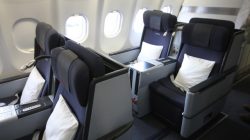Update: Explorer Awards are no longer available through the AAdvantage program, but this post has been left up for posterity.
American Airlines has a great mileage program, but their all-partner awards have restrictions that make certain awards difficult. These rules include:
1) Limited Stopovers. With AA, you cannot stopover anywhere internationally. You can only do stopovers at the North American gateway when awards include North America.
2) Maximum Permitted Mileage. AA allows MPM+25%, which can be generous, but there’s still a limit.
3) The transregion airline must publish a fare between the origin and destination. One non-alliance partner of AA, Etihad, serves Malé, but doesn’t publish fares from North America to the Maldives, so awards are not possible.
4) Transregion awards can only transit certain areas. One example of this is North America to India, which only be flown directly (with Middle Eastern carriers) or via Europe. However, Asia is a shorter routing to India from the west coast, but AA won’t allow you to redeem an award via Asia without paying extra miles. Another drawback is that you cannot transit upper South America for a trip between North American and lower South America, which has caused me to break up awards in the past.
Enter the AA Explorer Chart
The AA Explorer chart gets rid of those rules up there, and it makes a ton of sense for a lot of awards. The chart is a distance-based award chart, and there are four regions that looks interesting to me:
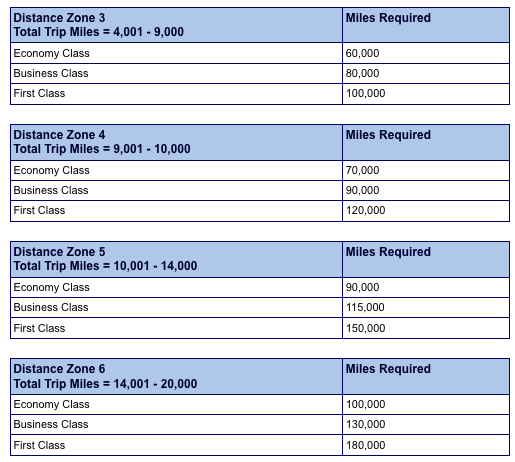
There are other rules that you have to follow with an Explorer award. This FlyerTalk thread goes over pretty much all of them, but some key rules are:
1) Must include 2 non-AA OneWorld partners. This means you cannot include non-alliance partners (like Alaska Airlines or Etihad) and must include two other carriers (which can be tough for somewhere like South America, which pretty much only has American and LAN, though there are possibilities as I will discuss below).
2) A maximum of 16 segments, with a maximum 1 open-jaw. An open-jaw that’s not between the first and last cities counts as a segment, as does a land segment between two co-terminals (like connecting between LaGuardia and JFK).
3) You can stopover at a city 1 time, and connect through a city 2 times. That means you could potentially fly through a city 3 times, but can stop there for just 24 hours once. Once you return to the first airport you departed, the award is pretty much over.
4) The total countable miles includes all flown segments, but not land segments. In addition, a flight has a layover on the same flight number, you’ll only be deducted the direct flight miles.
5) Award travel must be complete within a year of ticketing.
6) No changes to routing or carrier are allowed after ticketing, although date changes are fine.
Examples of Using the Explorer Chart to your (A)Advantage.
East Coast USA to Europe with stopovers
On their all-partner chart, AA charges 20K one-way in coach during off-peak (Oct 15 to May 15) 30K one-way in coach, 50K one-way in business, and 62.5K one-way in first.
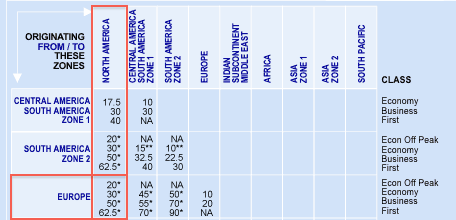
Round trip, that’s 40K off-peak coach, 60K in coach, 100K in business, and 125K in first.
In zone 3, 4001-9000 miles, AA charges 60K in coach, 80K in business, and 100K in first.
In zone 4, 9001-10000 miles, AA charges 70K in coach,90K in business, and 120K in first.
To me, zone 3 is the sweet spot, where you’re paying the same in coach and paying less for business and first. Zone 4 could also be a good choice if you’re flying business and first, but keep in mind that it’s only an incremental 1000 miles flown, which could be better served with using British Airways Avios for short flights.
In Europe, AA’s OneWorld partners are British Airways, Iberia, airBerlin, and FinnAir. In addition, LAN flies Madrid to Frankfurt as a fifth freedom route.
British Airways charges some nasty fuel surcharges, so we want to avoid them. Iberia also charges fuel surcharges for flights booked with AA miles, but their surcharges are much less — the highest is 30€ per segment. We’ll keep Iberia around, but try to limit their usage as much as possible.
Let’s look at one example that can work here:
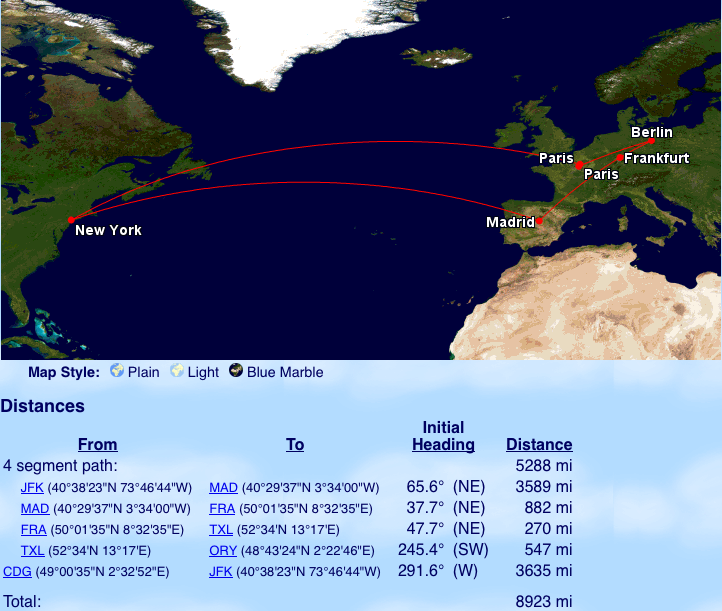
In this example, we’ll fly JFK to Madrid. This can be done on either American Airlines (without surcharges) or Iberia (with minimal surcharges).
From there, we fly from Madrid to Frankfurt, on LAN’s tag-flight on their A340. Once in Frankfurt, we will explore Germany on the ground, before making our way to Berlin. Once there, we’ll fly from Berlin to Paris-Orly on airBerlin, to see La Ville Lumiere. Note that we have satisfied the two-partner rule without having to take the Iberia flight from New York to Madrid. From Paris, we’ll fly home to New York on American Airlines.
This routing is under 8700 miles, including the surface segments between Frankfurt and Berlin and the two Paris airports. This means that we’d still have about 300 miles to work with in this example.
With AA’s normal all-partner chart, this example wouldn’t be possible, because you wouldn’t be able to stopover in multiple places. However, we can do so with the Explorer award while paying fewer miles.
Flying to India via Asia
Since a lot of my awards are for family and friends to go to India, AA’s routing rules are really a thorn in my side, since you can’t fly a Cathay Pacific award to India, even though it’s a shorter route from California. However, it’s possible with the Explorer Chart.
AA’s OneWorld Asia partners include Cathay and Japan Airlines. In addition, Royal Jordanian flies Hong Kong-Bangkok and Cathay Pacific flies Bangkok-Delhi and Bangkok-Mumbai.
For North America to India, it costs 45K in coach (90K roundtrip), 67.5K in business (135K roundtrip), and 90K in first (180K roundtrip). Keep in mind this is only possible via the Atlantic:
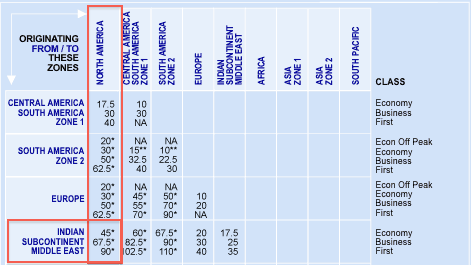
The sweet spot here is zone 6 (14001-20000 miles). It’s 100K in coach, 130K in business, and 180K in first. In premium classes, it’s the same price or less, in addition to having flexibility in routing.
Let’s look at some examples:
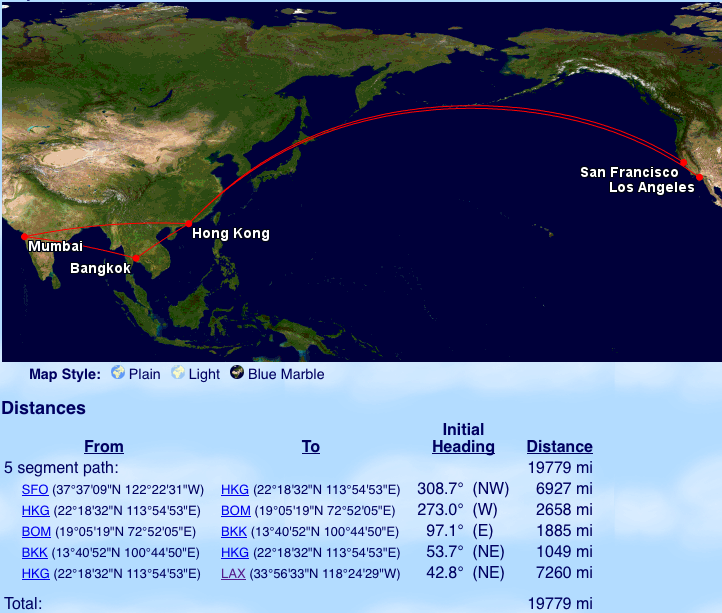
For this trip, we’ll fly from San Francisco to Hong Kong on Cathay Pacific. After some well-spent time in the Island City, we’ll head to Bangkok on Royal Jordanian. Already, we’ve satisfied the two partner rule. Royal Jordanian is great for this because they fly Hong Kong-Bangkok, and some of Cathay’s flights to Delhi and Mumbai fly through Bangkok anyway! From Bangkok, we’ll head to India on Cathay Pacific.
For the return, we’ll fly back on Cathay Pacific via Hong Kong. Even if you book the flight between Mumbai and Hong Kong that stopovers in Bangkok, you’ll have to follow the miles for the direct trip, since it’s the same flight number.
You’ll notice that in this example, I started in San Francisco and ended in Los Angeles. This is because starting and stopping in L.A. would make it go over 20,000 miles flown, and drastically increase the number of AAdvantage miles needed for redemption. This is where Avios comes into play.
Playing Around with Great Circle Mapper
All of these map images are courtesy of one of my favorite tools, the Great Circle Mapper, since it helps me visualize routing.
I noticed that the route between Hong Kong and California goes very close to Japan, so stopping over in Tokyo is definitely a possibility without adding too many miles.
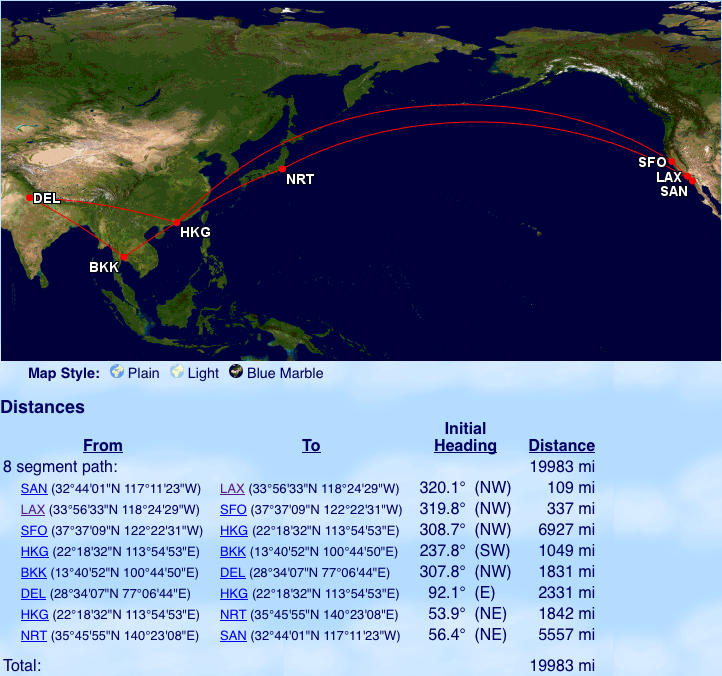
On this trip, we’ll fly San Diego to San Francisco on American Airlines. From there, San Francisco to Hong Kong on Cathay Pacific. From there, we can fly either Cathay or Royal Jordanian to Bangkok, and from there, Cathay Pacific to Delhi.
On the return, we’ll do Delhi to Hong Kong on Cathay Pacific, then Hong Kong to Tokyo on Cathay Pacific or Japan Airlines. Finally, we’ll use the new JAL 787 Dreamliner service to San Diego to finish the award.
This routing falls 17 miles under the 20,000 miles cap. Talk about maximizing!
Round-the-World (RTW) trips
From the east coast, it’s still possible to fly to India via Asia one-way and Europe the other, making it an RTW trip. For example, Cathay Pacific from JFK to Delhi on Cathay Pacific and Royal Jordanian from Delhi to JFK via Amman.
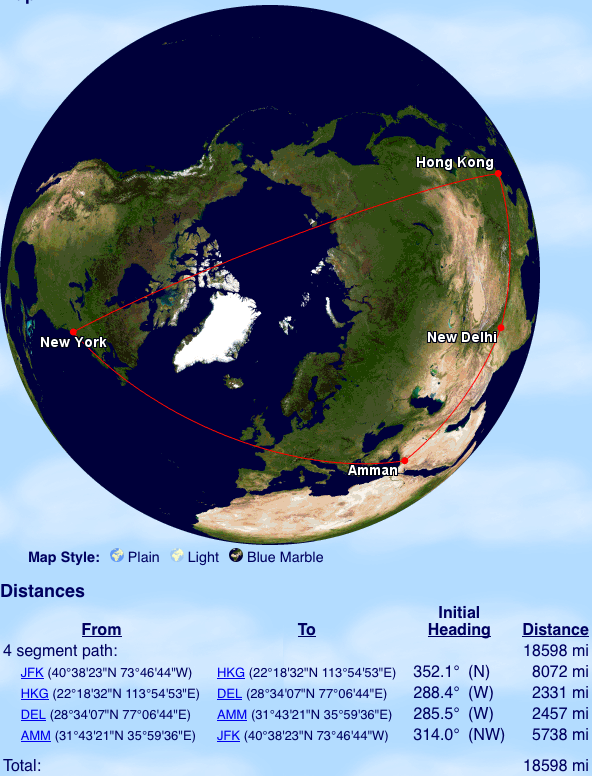
In fact, since the Amman -New York route goes over Europe, why not stop there as well?
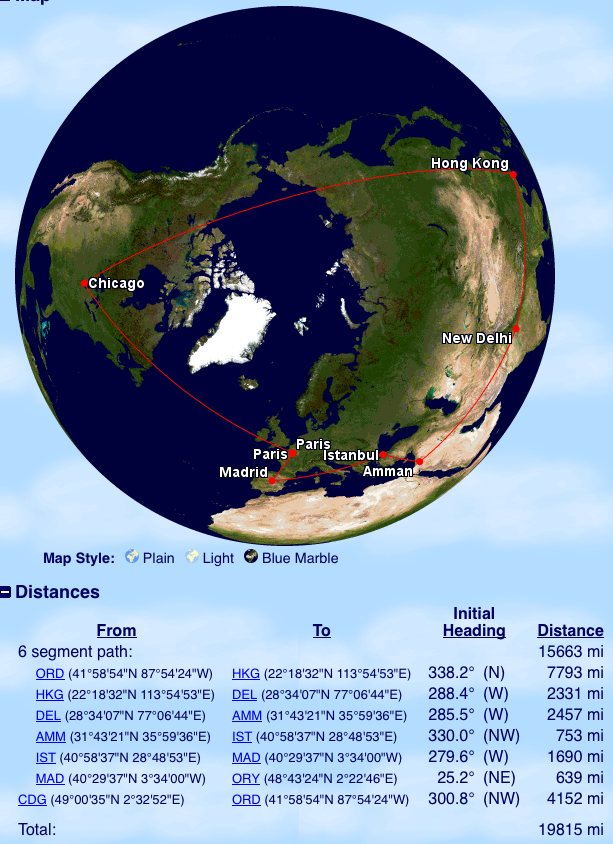
Chicago to Hong Kong to Delhi on Cathay Pacific, Delhi to Amman to Istanbul on Royal Jordanian, Istanbul to Madrid to Paris (Orly) on Iberia, Paris (CDG) to Chicago on American.
Increased flexibility with new partners and new routes
Future OneWorld partners include Malaysia Airlines (based in Kuala Lumpur), Qatar Airlines (based in Doha), and SriLankan Airlines (based in Colombo).
Besides the obvious routes from their hubs, it would be good to note the fifth-freedom routes these airlines serve. Of particular note is Qatar’s Buenos Aires-Sao Paulo route, which means that once they join OneWorld, you can use them to satisfy the two-partner rule along with LAN in South America.
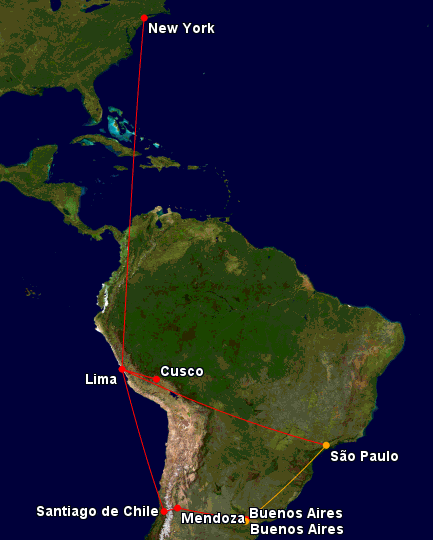
I hastily threw this itinerary together — it falls under 14,000 miles, qualifying it for Zone 5 pricing. All segments are on LAN except for the orange segment on Qatar.While you touch Lima 3 times, it still qualifies as a valid routing if you have 1 stopover and 2 connections.
Going all out, or how to plan 3.5 vacations with one award.
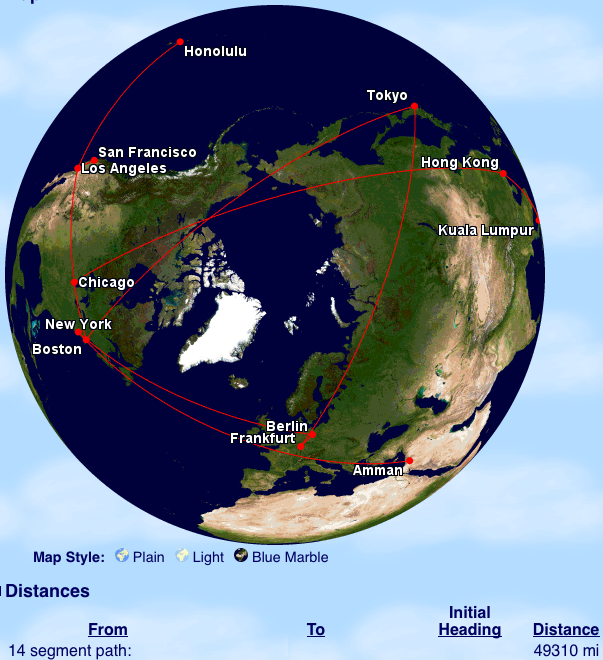
Believe it or not, the above Explorer award itinerary is actually 3.5 roundtrip vacations jam-packed into one business class award for only 220,000 American miles. To put that into perspective, one roundtrip to Europe without stopovers is 100,000 miles in business.
I recently read about Milepoint member DestinationDavid and his epic OneWorld Explorer itineraries. He recently posted about his two trips here, and it is definitely worth a read if the Explorer Award is something you’re interested in. He gives a lot of first-hand tips, like getting around the “only one stop in a city” rule by using connections rather than stopovers, and by booking outside tickets (either with cash or with Avios) to save a stopover for a later date. If you really want to go all out on an “advanced” OneWorld ticket, read that post!
Have some fun with it!
Play around with GCMap here and see what cities you can add without increasing the mileage price — if it comes to the point that you’re just barely going over a threshold for a zone, keep in mind that British Airways Avios are distance-based, and can help you reach a connecting city, and still be protected on separate tickets if you’re flying OneWorld.

